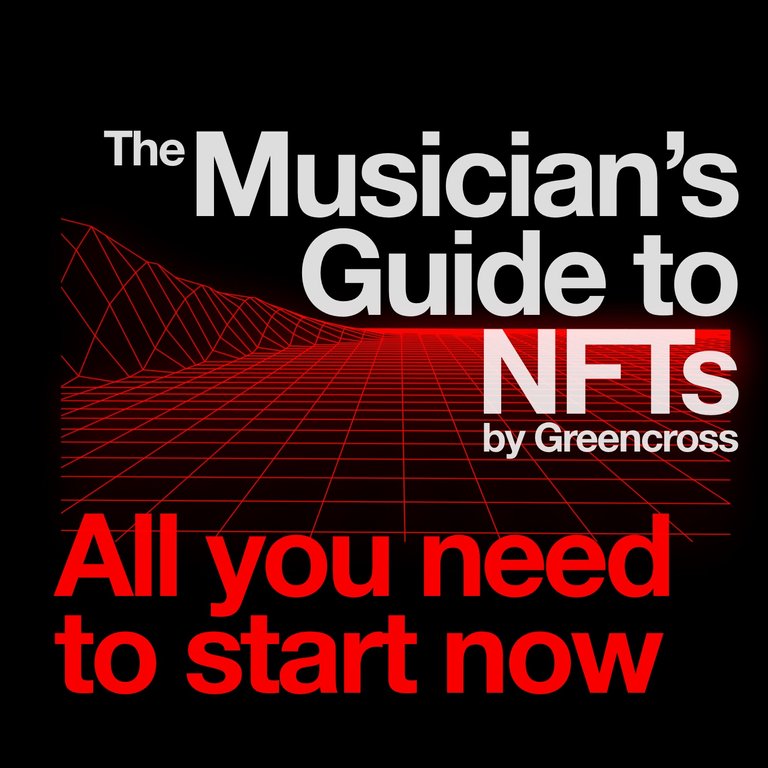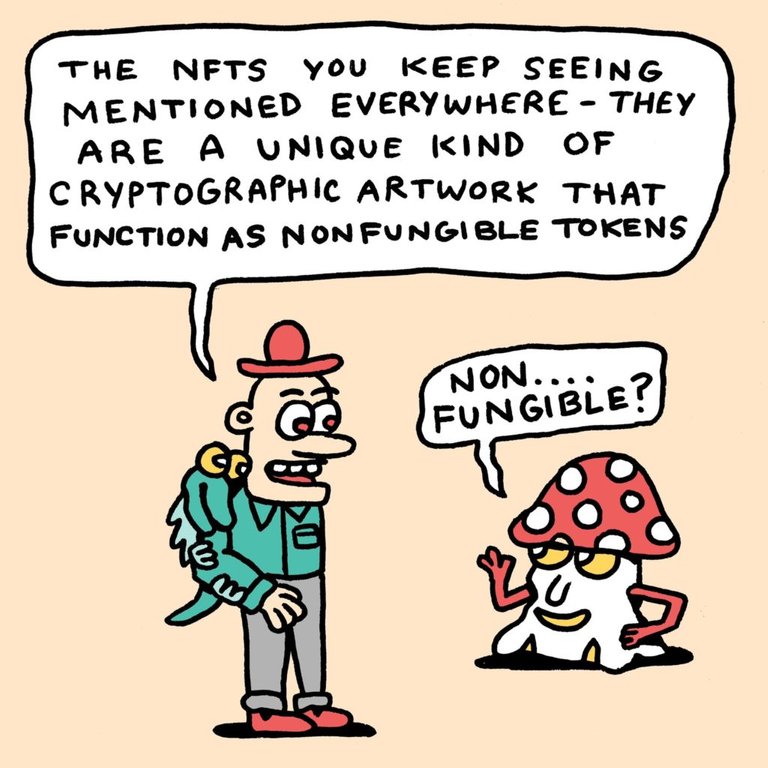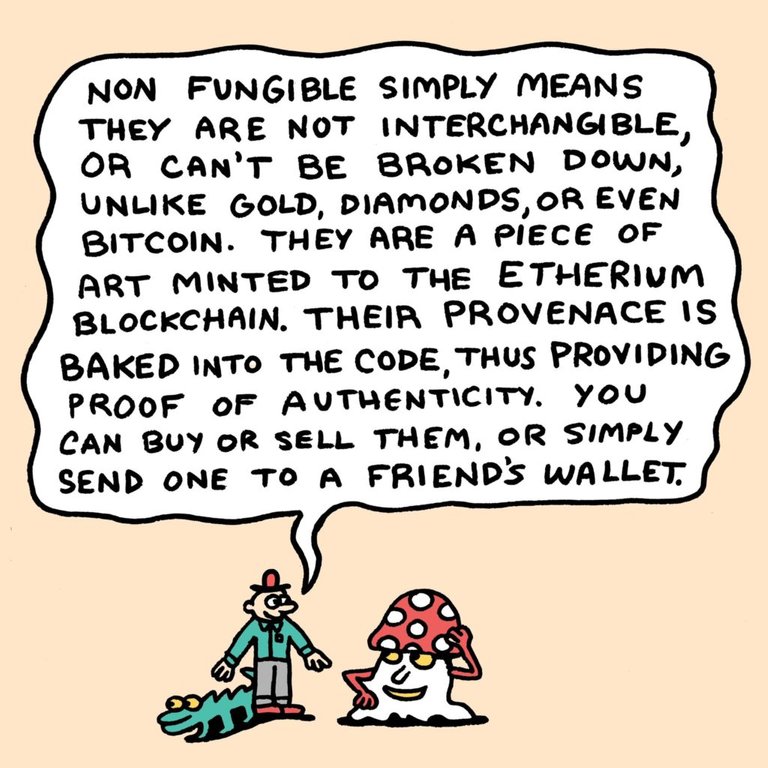
I have been looking at them for two years, and they are booming as you read this.
Warning: long article ahead. I have spread links throughout this post, it would be advisable to click on them in order to dig deeper on that specific matter. This is not financial advice, nor I am a financial advisor. Investing in crypto is a high-risk activity and you could lose all your money.
[toc]
Right now you might be wondering:
NFT?
NFT is the acronym for Non-Fungible Token.
What is a Non-Fungible Token?

Illustration by
In short words: it’s an immutable certificate of authenticity and ownership that lives forever in the blockchain.
“A non-fungible token (NFT) is a special type of cryptographic token which represents something unique; NFTs are thus not mutually interchangeable.[1] This is in contrast to cryptocurrencies like bitcoin, and many network or utility tokens,[a] that are fungible in nature.[2]”

What is blockchain?
The blockchain is a public distributed ledger of transactions. You can picture it as a public “excel” type of spreadsheet where all the transactions made on that specific blockchain are recorded. Anyone can audit transactions on a public blockchain. Therefore, everything is transparent and cannot be ever changed. In order to change a record on certain blockchains, especially those that use a Delegated Proof Of Stake algorithm, a Sybil attack or a “Collusion” of the 51% of the validators must occur, and it is almost impossible to happen on a decentralized blockchain.
Nevertheless, we did see it happen last year with Steem when Justin Sun colluded with Binance and other exchanges to create a Sybil attack that allowed Sun to phase out the legitimately community-elected top 20 witnesses (validators) and execute the first hostile takeover of a blockchain in history.
What is a validator?
A Blockchain Validator is someone who is responsible for verifying transactions within a blockchain.
A validator is also called “miner” or some times “node”. They are computers that process each transaction on the blockchain and validate them. Once a minimum amount of miners have validated a transaction, then “consensus” between validators is reached settling the time frame when each transaction took place. After that, the transaction is included in the block and the block is then added to the chain. The validators receive a reward for each block they finish and is added to the chain, and in the case of bitcoin, the reward is quite substantial per finished block. In the case of legacy blockchains like Bitcoin and Ethereum solving a block takes enormous amounts of computer processing power and electricity. This is one of the many reasons that make cryptocurrencies valuable.
Learn about the difference between validation and consensus here.
Back to NFTs: What does “minting” mean?
Minting is the process of tokenizing your work and creating an NFT.
When you “mint” an NFT and tokenize a digital file of any kind, you actually create a “smart contract” on the blockchain. The terms of the smart contract will depend on the options given by the NFT marketplace at the moment of minting and could potentially be whatever you want them to be. However, keep in mind that different marketplaces offer different options for minting NFTs.
Minting doesn't mean it's set for sale, yet
You can perfectly mint an NFT and never set it for sale. It will sit on your wallet until you send it to someone else's wallet, or until you decide to list it for sale later. If your NFT not for sale, it could even be more valuable. Does this make sense?, I know it doesn't.
Who’s the owner of an NFT?
In the crypto art world, NFT smart contracts are made in a way that whoever gets to purchase or win an auction for an NFT is therefore the owner of the tokenized piece.
As a collector, you can either bid or directly purchase an NFT. Once you purchase or win the auction on the NFT, said NFT will be “sent” to your crypto wallet.
How are the collections displayed?
Your collection will be displayed on your profile page in the platform where it was minted and in other platforms that are compatible with said NFT, like OpenSea, Looksrare, Gem, etc.
How does the artist get paid?
As an artist, when your NFT is sold, you get immediately paid on your wallet. And if the collector who bought your piece resells the NFT, you will earn a percentage, perpetually.
There are novel marketplaces that let you set royalty splits, meaning that the payment will be automatically divided between different wallets in percentages defined at the moment of minting and listing.
How to prove you own an NFT?
NFTs are assigned to the wallet that purchases them or the wallet that receives them as a present. Since only the owner of said wallet can unlock it, therefore the individual who owns the keys of the wallet and can successfully unlock it is the rightful owner of the artwork the said NFT represents.
NFT’s most common misconception
“Well, but it is just a digital file, anyone can have a copy”.
— You, right now
Here is where the smart contracts come into play: anyone can have a copy of the file, but only you, as the owner of the NFT can sell it, and that specific NFT can only be found in your wallet. This is sufficient proof of ownership. However, depending on the code in the contract, functions could be programmed into the smart contract that could allow the deployer of said smart contract to "move" an NFT from a wallet into another without the wallet owner's consent.
Please check out this article for a deeper insight about NFTs and the music industry.
How to start as a musician with NFTs and cryptocurrencies?
Important: your first steps on crypto should be baby steps. Remember, any operation on the Ethereum blockchain spends Gas, which is essentially a fee. To mint a piece on the blockchain you will have to pay fees. Minting and setting an NFT for sale is not free. You could potentially lose money if your piece doesn’t sell, or if it sells for less than the gas fees you paid.
Remember: do your own research and do not take this as financial advice, because it isn’t.
Some links below are my referral links, which means that when you use them, we both get bonuses if you register.
First of all, you will need to create a wallet that works with the blockchain of your choice. There are plenty of them, but I recommend the ones below.
For Ethereum:
- Metamask (please install the app on your phone and the browser extension on your Brave, this will make things much easier)
- Trust Wallet (open source, developed by Binance. Great for you smartphone)
For Tezos:
- Temple Wallet (please install the browser extension on your Brave browser)
- Airgap Wallet (for your smartphone)
REMEMBER TO ALWAYS WRITE DOWN ON PAPER YOUR PRIVATE KEY AND/OR YOUR SEED PHRASE.
Never store your seed phrase or your private keys in any computer or on your email. anyone who can access this data can potentially wipe out everything in your wallet.
“Not your keys, not your crypto”
Whenever you open a new wallet, remember the mantra above because it will help you safeguard your funds.
Public-key cryptography, or asymmetric cryptography, is a cryptographic system which uses pairs of keys: public keys (which may be known to others), and private keys (which may never be known by any except the owner). The generation of such key pairs depends on cryptographic algorithms which are based on mathematical problems termed one-way functions. Effective security requires keeping the private key private; the public key can be openly distributed without compromising security.[1]
The problem with private, centralized crypto exchanges and wallet providers is that they normally do not give you your private keys or wallet seed phrase.
When a wallet provider or an exchange doesn’t give you access to your private keys or seed phrase (the equivalent of user name and password on the crypto world), it means your funds are ultimately at the mercy of the exchange or the wallet provider.
You must be very careful with trusting too much of your crypto to these exchanges, platforms or wallets that do not provide you with seed phrases or private keys. Why? because this means if the exchange or the wallet provider stops operating for any reason you could be locked out of your funds and lose them forever. It has happened several times in the past. The most notorious case would undoubtedly be Mt.Gox.
This is why one of the most famous mantras in crypto is “Not your keys, not your crypto”.
Secure your seed phrase or private keys
After you register your wallet, you’ll be provided with a seed phrase. This serves as an emergency recovery system in case you lose your phone or computer and in other scenarios. Never reveal your seed phrase to anybody.
The same goes for sites that provide you with private keys: never reveal your private keys to anyone and store them in a safe place, preferably on paper.
Register on an NFT marketplace
There are a huge amount of NFT marketplaces, I have minted NFTs on Manifold, Rarible and NFT Showroom.
Rarible runs on the Ethereum blockchain, therefore you need to spend money to successfully mint NFTs and set them for sale. This is more recommended for experienced users since it incurs an investment. NFT
Other NFT marketplaces:
- Wax (eco-friendly)
- Flow (eco-friendly)
- OBJKT (eco-friendly)
- SuperRare
- Looksrare
- Foundation
- OpenSea
- Known Origin
- Nifty Gateway
Fund your wallet with ETH
Important: As stated before, almost any transaction on the Ethereum blockchain incurs gas fees. Therefore, make sure to have enough ETH in your wallet in order to be able to pay for fees. To know the current gas fees check ETH Gas Station.
To fund your wallet with ETH you need to buy it with your credit card or via bank transfer using what is known as a "gateway" from fiat money to crypto.
The ones I recommend are in first place Wirex and in second place Crypto.com . They are both smartphone apps but Wirex offers also a web application.
After you register your account and verify your identity on Wirex or Crypto.com you'll be able to link your bank account and your credit card in order to purchase your first cryptocurrency.
Follow the instructions provided on the Wirex or Crypto.com apps to link your bank account and your credit card and once ready, proceed to buy some ETH so you can, later on, pay the fees for minting your first NFT. Be sure to at least buy a 100 USD on ETH, to be sure you will have enough to cover the fees for minting at least two NFTs.
Wirex and Crypto.com will also serve you as a gateway if you ever want to cash out your crypto back into fiat money. You can send crypto from your Metamask to Wirex or Crypto.com, convert it into fiat money and have it transferred to your bank account. You could directly spend it directly using Wirex or Crypto.com's debit cards, as well.
Your genesis piece needs to be your best work to date
Now please pay attention because this is of extreme importance:
There were some things I would have liked to know back when I minted my first piece on Rarible.
You do not want to half-ass your inaugural piece on the blockchain, remember, it's immutable!. You can't change anything about your piece once it's minted. Not the title, not the image, not the description. Everything on your NFT will forever stay as you initially made it. Therefore it's paramount to always make a conscious decision about which artwork will be your genesis piece and figure out how it relates to your subsequent ones.
I don't think I half-assed my genesis piece, but I would have at least used an animated image for them.
Remember you will also need to hone your marketing skills to promote your piece after it is minted. The marketing must be aligned with your NFT release strategy and your core values. This will help set you apart from the rest.
Mint your genesis piece
Once you have decided what strategy will you follow to release your NFTs, you should proceed to mint your first piece.
Depending on the platform you are on, there will be a button that will allow you to create an NFT. Normally the button reads "Create" on Rarible, and it's at the top right corner of their website.
Protip: mint once on OpenSea and you can mint for free thereafter IF you don't auction but set a fixed price. If it's an auction, you pay the gas fee. If it's a fixed price, the buyer pays the gas.
Single or multiple editions?
You can choose “Single” if you want your collectible to be one of a kind or “Multiple” if you want to sell one collectible multiple times.
It works more or less like this: on the Single editions, or 1 of 1 the collector who buys it will own the full piece. On the Multiples, each buyer will own a fraction of the artwork. Obviously, a Single edition should be intrinsically more valuable than one of the Multiples.
Your choice here must ultimately depend on your strategy.
Set your NFT for sale
There are two ways of selling an NFT, with a fixed price and by taking bids.
Both ways have their pros and cons, and you should choose the option that is aligned with your master plan. Basically with a fixed price you choose how much crypto you want to get paid for the NFT, while on the bidding format the sale price may vary and you can always set a reserve price (minimum amount of crypto for what you would sell the piece for).
Market the crap out of your NFT
People need to know that you have made your first NFT. If you are a pro artist, for sure you have a PR agency who can help you spread the word with blogs and magazines.
If you are on your own, you must be on Twitter. Twitter is one of the places where most of the crypto artists, collectors and enthusiasts are. Make an account, start researching hashtags and current NFT artists. Get social and drop the occasional tweet about your artwork.
Create a Reddit account if you don't have one, follow r/CryptoCurrency, r/NFTMusic, r/CryptoArt and any subreddit that you think might be useful for your endeavour. Start participating in the community, learn and subtly drop links to your artwork, without breaking any of the subreddit's rules. Many collectors lurk on Reddit as well.
A good idea is reaching to crypto influencers on Youtube and try to find an interview with them, or get them to talk about your newly minted NFT, or your upcoming NFT collection.
If you are an artist with a considerable amount of followers you should ponder the idea of reaching out to the NFT marketplace where you minted your piece and pitch them your NFT. If they like it, there's a possibility they give you some website real state to showcase your work to all the visitors.
Spare no effort on this phase.
Start your own collection and support other artists
The crypto space in general is of collaborative nature, without each other we wouldn't be anybody. It's a great idea to start purchasing pieces you like and can afford. Some pieces might increase in price, some might not, but what will not decrease is the feeling you get when you know you are helping someone achieve their dreams. Needless to say, doing these acts of kindness will bring you many benefits, not only monetary.
Keep learning and enjoy the ride
NFTs are just one of the tools that musicians and artists, in general, can use to generate cryptocurrency. I will cover the most relevant ones in another post.
Blockchain, NFTs, cryptocurrencies and everything related to this new technology still is in its infancy. The more knowledge you acquire about it, the better you will do. Beware of the scams, stay away from anything that promises you a quick buck and please, enjoy your crypto journey.
You are now part of the early adopters. This is a privilege.
Thanks a lot for reading, and feel free to ask your questions in the comments below.

Thanks a lot for sharing this very useful stuff!
Thank you for reading and I hope you could find it valuable!. If you have any questions, feel free to ask!